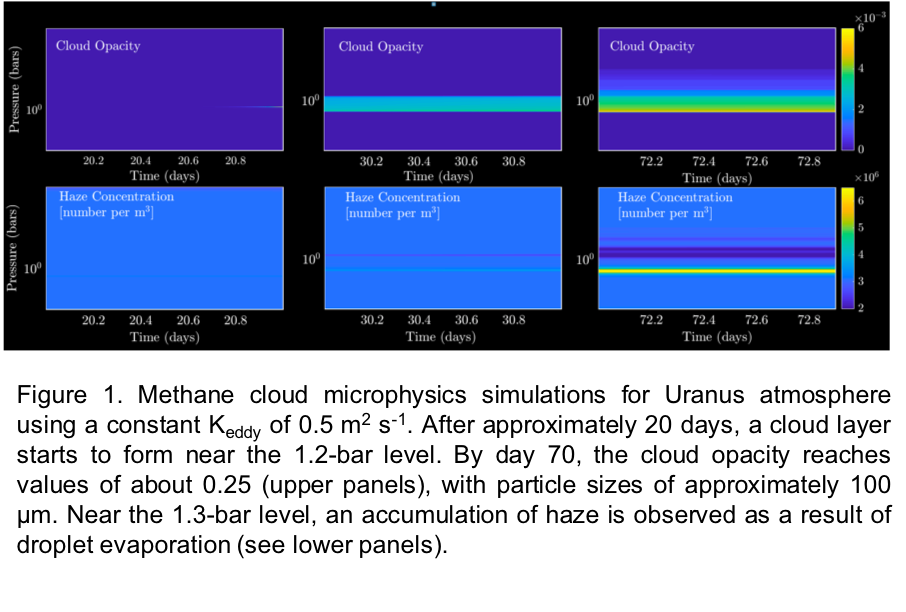Microphysical modeling of methane ice clouds in the atmospheres of the Ice Giants.
- 1Instituto Nacional de Técnica Aeroespacial (INTA), Madrid, Spain, Madrid, Spain (toledocd@inta.es)
- 2Université de Reims Champagne-Ardenne, Reims, France
- 3Department of Physics, University of Oxford, Parks Rd, Oxford OX1 3PU, UK
- 4University of Leicester, UK
Voyager 2 radio occultation measurements of Uranus and Neptune revealed a layer approximately 2-4 km thick near 1.2 and 1.6 bars, respectively, wherein the atmospheric refractivity exhibited a slope variation (1, 2). These findings were interpreted as indicating a region where methane gas was undergoing condensation, forming an ice cloud centered around this pressure level. While the formation of this putative cloud would explain the observed decrease in methane abundance with height above 1.2 and 1.6 bars, or the banded structure of Uranus through latitudinal variations in the opacity of this cloud, several recent works and observations do not provide direct evidence in favor of this cloud (3): (i) radiative transfer models show an enhancement in the scattering opacity at pressures near 4-6 bars, more consistent with the presence of H2S ice (4, 5); (ii) observations from ground-based telescopes (or observations from telescopes in orbit around the Earth) of methane clouds indicate cloud tops near 0.4 bars in both planets (6), approximately a scale height above the base of the putative methane cloud.
To investigate the formation of methane clouds in the atmospheres of the Ice Giants, we employed a one-dimensional cloud microphysical model originally developed for Titan and Mars (7,8). This model includes the processes of nucleation, condensation, coagulation, evaporation, precipitation, and coalescence. In the model, vertical transport is parameterized using an eddy diffusion profile (Keddy). Figure 1 illustrates, as example, cloud microphysics simulations carried out for the atmosphere of Uranus, assuming a constant Keddy in the troposphere and a concentration of haze particles (cloud condensation nuclei-CCN) of 3 particles per cm3. For this scenario, the model indicates the formation of a cloud layer near the 1.2-bar level with high precipitation rates and haze scavenging.
In this work, we will discuss the different scenarios that may lead to the formation of methane clouds in the Ice Giants, as well as the cloud properties (e.g., precipitation rates, particle radius, and opacity) derived from the model. These results will be compared against observations and previous works, and we will evaluate the differences with respect to the methane clouds observed in Titan’s atmosphere, focusing on parameters such as lifetime or particle radius.

References: [1] G. F. Lindal, et al., Journal of Geophysical Research: Space Physics 92, 14987 (1987). [2] G. Lindal, et al., Geophysical Research Letters 17, 1733 (1990). [3]. L. Sromovsky, P. Fry, J. H. Kim, Icarus 215, 292 (2011). [4] P. G. Irwin, et al., Nature Astronomy 2, 420 (2018). [5] P. G. Irwin, et al., Icarus 321, 550 (2019). [6]. E. Karkoschka, Science 280, 570 (1998). [7] P. Rannou, F. Montmessin, F. Hourdin, S. Lebonnois, science 311, 201 (2006). [8] F. Montmessin, P. Rannou, M. Cabane, Journal of Geophysical Research: Planets 107, 4 (2002).
How to cite: Toledo, D., Rannou, P., Irwin, P., de Batz de Trenquelléon, B., Apestigue, V., Roman, M., Arruego, I., and Yela, M.: Microphysical modeling of methane ice clouds in the atmospheres of the Ice Giants., Europlanet Science Congress 2024, Berlin, Germany, 8–13 Sep 2024, EPSC2024-818, https://doi.org/10.5194/epsc2024-818, 2024.